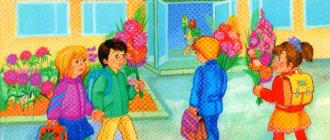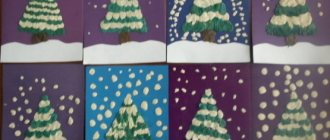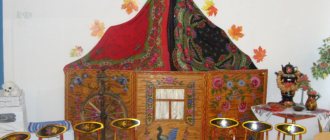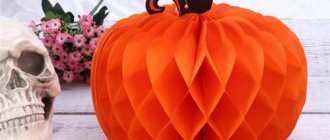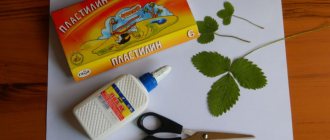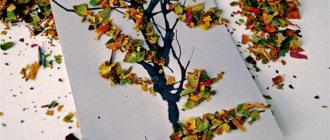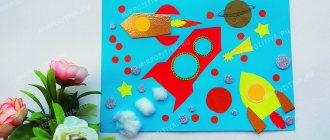Circle applique
The first paper products that even three-year-old children can make are fruit appliques from multi-colored circles. Riddles, songs, counting rhymes, sayings and proverbs on the topic will help to interest the kids.
Creative activity will not be boring if you make a note that reflects what goals you need to achieve:
- Talk about the benefits of the fruit.
- Learn how to glue round shapes using glue.
- Fix shapes and colors.
- Instill neatness.
Preschoolers do not yet master concepts and think only in visible, concrete images. Therefore, for practicing applique, visual material is prepared: apples of three colors of different sizes on a plate. Adults also cut out blanks from paper:
- A white circle with a radius of 20 cm is for the base.
- Yellow, red and green circles are for fruits.
With children, they look at each apple on the plate, analyze the sizes and differences. They offer to capture them by accurately laying out colored circles on the base.
Then they begin the practical part: they are introduced to the simple technique of paper appliqué. They show how to smear parts and press them onto paper using a napkin.
Literature on the topic to help the teacher
When choosing a technique and type of application on a specific topic, it will be useful for the teacher to familiarize himself with the following manuals:
- Boychenko O., Starikova E. Development of creativity in applique classes // Preschool education - 1989.
- Dubrovskaya N.V. Application from natural materials, M.: 2011.
- Komarova T.S. Visual activities in kindergarten: Education and creativity, - M.: Pedagogika, 1990.
- Kazakova T.S. Visual activity and artistic development of preschool children, - M.: Pedagogika, 1993.
- Kazakova T.G., Lykova I.A. Fairy-tale image in fine art or “Bring the fairy tale to life” // Preschool education. – 2005.
- Kozhokhina S.K. We grow and develop with the help of art, - St. Petersburg: Rech, 2006.
- Lykova I.A. Visual activities in kindergarten, - M.: “Karapuz - didactics”, 2006.
To compile lesson notes on application, the following materials will be informative:
- Program “From birth to school” / (edited by N. E. Veraksa, T. S. Komarova, M. A. Vasilyeva, - M.: Mozaika-Sintez, 2014.
- Komarova T. S. Visual activities in kindergarten. Preparatory group for school. – M.: Mosaic - Synthesis, 2014.
- Tsirulik N.A., Prosnyakova T.N. Lessons in creativity, - Samara: Fedorov Corporation, Publishing House "Educational Literature", 2004.
Lessons on applique in the preparatory group are an important element of the creative development of children. In addition, children like this type of activity, it helps expand their understanding of the world around them, trains fine motor skills and helps form ideas about working in a team. In other words, the application in the system of working with children 6–7 years old has extensive methodological potential.
Literature on the topic to help the teacher
Notes on application nodes for the preparatory school group “summer fantasies”
When choosing a technique and type of application on a specific topic, it will be useful for the teacher to familiarize himself with the following manuals:
- Boychenko O., Starikova E. Development of creativity in applique classes // Preschool education - 1989.
- Dubrovskaya N.V. Application from natural materials, M.: 2011.
- Komarova T.S. Visual activities in kindergarten: Education and creativity, - M.: Pedagogika, 1990.
- Kazakova T.S. Visual activity and artistic development of preschool children, - M.: Pedagogika, 1993.
- Kazakova T.G., Lykova I.A. Fairy-tale image in fine art or “Bring the fairy tale to life” // Preschool education. – 2005.
- Kozhokhina S.K. We grow and develop with the help of art, - St. Petersburg: Rech, 2006.
- Lykova I.A. Visual activities in kindergarten, - M.: “Karapuz - didactics”, 2006.
To compile lesson notes on application, the following materials will be informative:
- Program “From birth to school” / (edited by N. E. Veraksa, T. S. Komarova, M. A. Vasilyeva, - M.: Mozaika-Sintez, 2014.
- Komarova T. S. Visual activities in kindergarten. Preparatory group for school. – M.: Mosaic - Synthesis, 2014.
- Tsirulik N.A., Prosnyakova T.N. Lessons in creativity, - Samara: Fedorov Corporation, Publishing House "Educational Literature", 2004.
Lessons on applique in the preparatory group are an important element of the creative development of children. In addition, children like this type of activity, it helps expand their understanding of the world around them, trains fine motor skills and helps form ideas about working in a team. In other words, the application in the system of working with children 6–7 years old has extensive methodological potential.
Theoretical nuances
Applique is a type of productive activity that is based on the creation of plot compositions from paper, fabric, natural material, glued or sewn onto a thick cardboard or paper (rarely wooden) backing.
Paper appliqué in the preparatory group is complicated by cutting out bends and curls, including along diagonal lines
The goals of applique classes, while being the same for working with preschoolers of any age, in the preparatory group have a number of features:
- the development of highly coordinated movements of the muscles of the hands helps children master the skill of writing;
- stimulation of the skill to concentrate and manage one’s activities;
- assistance in complicating the mechanisms of thinking with images (at 5–6 years old, children composed coherent descriptions of their crafts, and in the preparatory group they learn to fantasize about a topic, breaking the plot into fragments, a kind of “series”);
- consolidating the skill of completing a task according to a model, that is, the priority way of working in the lower grades;
- the practice of orientation in space in the process of arranging the details of the composition within the boundaries of the substrate;
- speech development (kids learn to come up with stories based on crafts, using not only simple sentences, but also complex and complicated phrases);
- cultivating the ability to evaluate one’s own activities and the work of one’s comrades.
In the preparatory group, developing the skill of working both together and just side by side continues
Tasks aimed at achieving these goals include:
- the practice of creating subject and plot compositions from nature and from imagination (that is, individual objects, for example, “Bookmark”, and combinations of objects within the framework of a general scene, for example, “Swans swim in the pond”);
- developing the ability to combine different types of techniques in one craft (for example, in the work “Food”, children make vegetables in a cut-out form, a plate in a flat form, and cutlery in a silhouette form);
- practicing cutting out parts that differ in shape and size;
- the practice of cutting out symmetrical elements from a sheet of paper folded in half, as well as paired parts from a sheet assembled with an accordion;
- familiarization with cut-out decor, when the decorations of the elements are not glued on, but cut through (for example, “Snowflakes”);
- developing the ability to share responsibilities while performing a task in a group or pair;
- nurturing a sense of color, proportionality of composition, measures in the use of decorative elements (beads, buttons, etc.);
- stimulating interest in creating stories on nature and fairy tales;
- training the skill of reflection (older preschoolers not only say whether they like their craft or not, but also justify why).
New appliqué techniques for children 6–7 years old
In general, at 6–7 years old, kindergarten students systematize all the skills that they have previously mastered. But still the emphasis in the work is on:
- the ability to use scissors to cut out elements by eye, observing proportions (for example, vegetables and fruits), silhouette and ribbon appliqué (the difficulty of cutting out such details lies in the fact that the child, when cutting out individual details, for example, the outlines of the paws and tail of an animal, holds a complete image of the image in the head, coordinating the movement of the hand with the imaginary form);
- drawing up plot pictures (for example, based on fairy tales), as well as compositions that are as close to realistic as possible (still lifes, landscapes);
- developing the skill of making markings on paper, using a stencil, template, carbon paper, sketching against the light, by eye, or by folding the sheet;
- developing the ability to compose a composition from several elements, evenly placing them on a substrate and thinking through the decorations of each (for example, when making a “Country House” craft, children not only convey all the details of the real picture - a fence, a vegetable garden, paths, etc., but also they come up with decorations for the house itself - tiles on the windows, carvings on the railings at the entrance, etc.);
- practicing a broken type of appliqué to create clouds, sea foam, etc.;
- complication of color combinations (children practice combining elements of more than 4-5 shades within one plot).
In the preparatory group, children continue to experiment with the shape of the substrate

